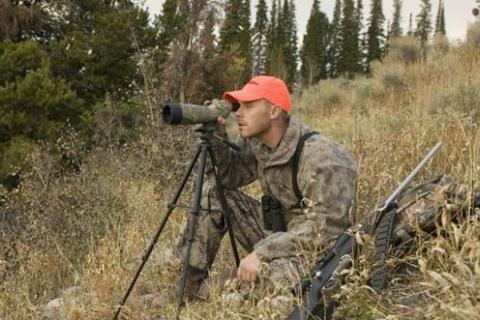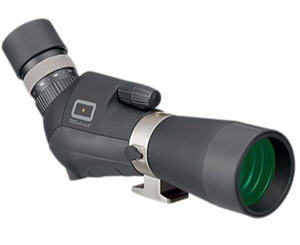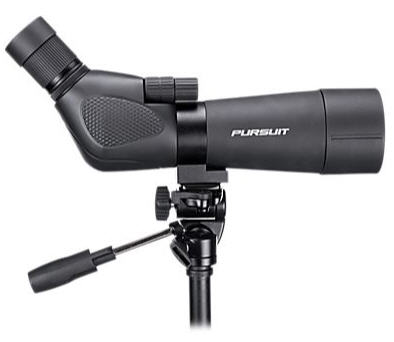
 |
| Spotting scopes like this Oculus spotting scope not only allow you to spot game from greater distances, but also allow you to size up a potential trophy from a few miles away. |
Binoculars are standard equipment for most big game hunters. Similarly, most rifles today are equipped with a scope, even in the whitetail woods of the North and East. In addition to these important optics, however, spotting scopes can also be an extremely useful piece of equipment, especially out West.
Spotting scopes are available in various magnifications, but all are more powerful than most binoculars. This increased magnification can be vital when hunting open country for game species such as the big bears, pronghorns, mule deer and caribou, or mountain species such as sheep and goats. Spotting scopes can not only allow you to spot game from greater distances, but being able to size up a potential trophy from a few miles away can save hours of time stalking an animal that turns out to be not what you're looking for. Here's what you need to know to choose a spotting scope that's right for you.
Understanding Terms in the Optics Industry
In order to make an informed choice, you first need to understand some of the terms used in the optics industry, and what they mean. The specifications of a typical spotting scope are usually stated as follows: 18-36 x 50mm, or 20 x 65mm, or some variation thereof. The numbers before the "x" refer to the magnification of the scope, and this can be a variable number, such as 18-36 in this case, or a fixed number, such as 20. Whatever the number, it means that your target will appear that many times closer than it actually is. The number following the "x" refers to the diameter of the objective lens (the lens facing toward the target; the lens closest to your eye is called the ocular lens or eyepiece), expressed in millimeters.
All spotting scopes are either fixed-power or variable-power. Fixed models are permanently set at a given level of magnification, while variables can be adjusted within their set range. While the simplicity of a fixed-power spotting scope may appeal to some hunters, the versatility of a variable model is hard to beat and those in the range of 15-45x, 16-48x or 20-60x now dominate the market. Once you've spotted an animal that you're interested in, a variable-power spotting scope allows you to crank up the magnification to its highest setting to closely examine the finer trophy details. While scanning for game, however, it is important to keep the scope on a lower setting as the higher the magnification, the smaller the scope's field of view (F.O.V.), and a small field of view makes it difficult to locate your target through the scope. For this reason, some models come equipped with a simple external peep sight that allows for target acquisition before viewing through the high-powered lens.
Understaning the Lens Options of a Spotting Scope
When it comes to the scope's objective lens, they can commonly range in size from 50mm to 80mm in diameter. The bigger it is, the larger the field of view will be at any given magnification setting, but also the brighter the scope will be, depending upon the coatings on the internal glass surfaces. High-quality spotting scopes have the ability to gather available light into the scope and utilize it in such a way that you can actually see better during low-light conditions while looking through the scope than you can with the naked eye. The key term here, however, is high-quality, but what makes a high-quality scope?
In order to reduce glare and the amount of available light lost during transmission from the target to your eye, special chemical coatings are applied to the surface of a lens. The quality, number and position of these coatings determine how much light is transmitted. Here are the options available and what they mean:
- Coated - a single layer is applied to at least one lens surface
- Fully-coated - a single layer is applied to all air-to-glass surfaces
- Multi-coated - multiple layers are applied to at least one lens surface
- Fully multi-coated - multiple layers are applied to all air-to-glass surfaces
 |
| Spotting scope kits like this Pursuit Spotting Scope Kit contain accessories such as tripods and window mounts offer excellent value. |
The more coatings that are applied to the lenses, the more expensive the scope will be, and top-quality scopes are not cheap; however, you do get what you pay for. Expect to pay anywhere between $150 and $1,500 for a spotting scope. The rule of thumb when it comes to optics is to buy the best that you can afford and you won't regret it. Not only are high-quality optics clearer and brighter, but they won't cause headaches or eye fatigue from hours of glassing the way that cheap optics can, and they will last several lifetimes.
What else do you get for this money?
Many spotting scopes are rubber-armored, to provide some protection against bumping and banging in the field. Most are even waterproof. Compact models that will easily fit in a pack are also available, as are top-quality high-definition models that offer increased resolution and color reproduction. Many spotting scopes today are offered as part of a kit, containing a hard and/or soft carry case, a small tripod and even a special car window mount for use from hunting vehicles. These kits offer excellent value.
If you aren't just a big game hunter, but you're also a target shooter or wildlife photographer, you can get extra use and value from a spotting scope. A spotting scope set up beside you at the shooting range, whether you're competitive shooting, plinking or just sighting-in your hunting rifle, will save you many walks down-range to check your targets, as most riflescopes and binoculars simply don't offer enough magnification to see a tiny bullet hole in a piece of paper 100 or more yards away. To top it all off, you can also buy an adapter for some models that will allow you to attach the scope to the body of a 35mm or digital SLR camera, giving you an extremely useful telephoto lens for long-distance photography, or "digiscoping."
Binoculars and riflescopes are great, but if you really want to spot game from a long distance, or get an up-close and personal look at a potential wall-hanger before you start a stalk, a spotting scope is the only way to go.
![]() Tip: Check out the popular and quality Oculus Optics & Scopes at Bass Pro Shops.
Tip: Check out the popular and quality Oculus Optics & Scopes at Bass Pro Shops.
- 29744 views

